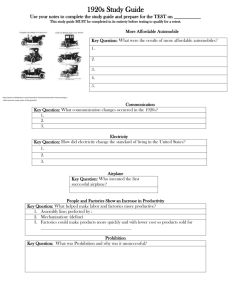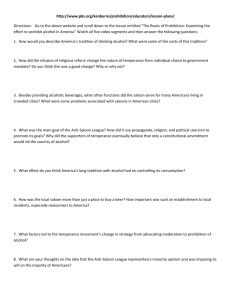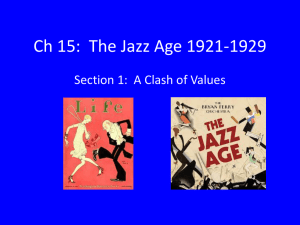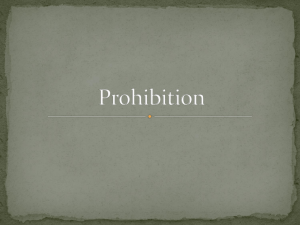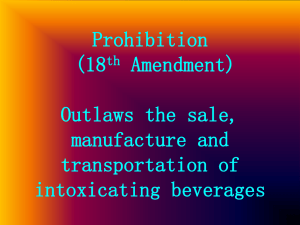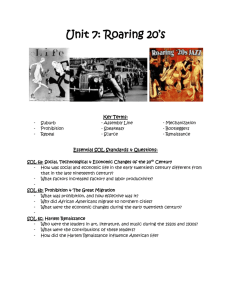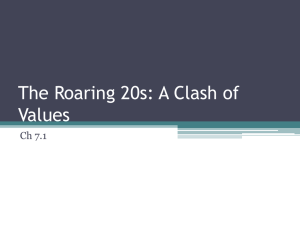Learning Goals
advertisement
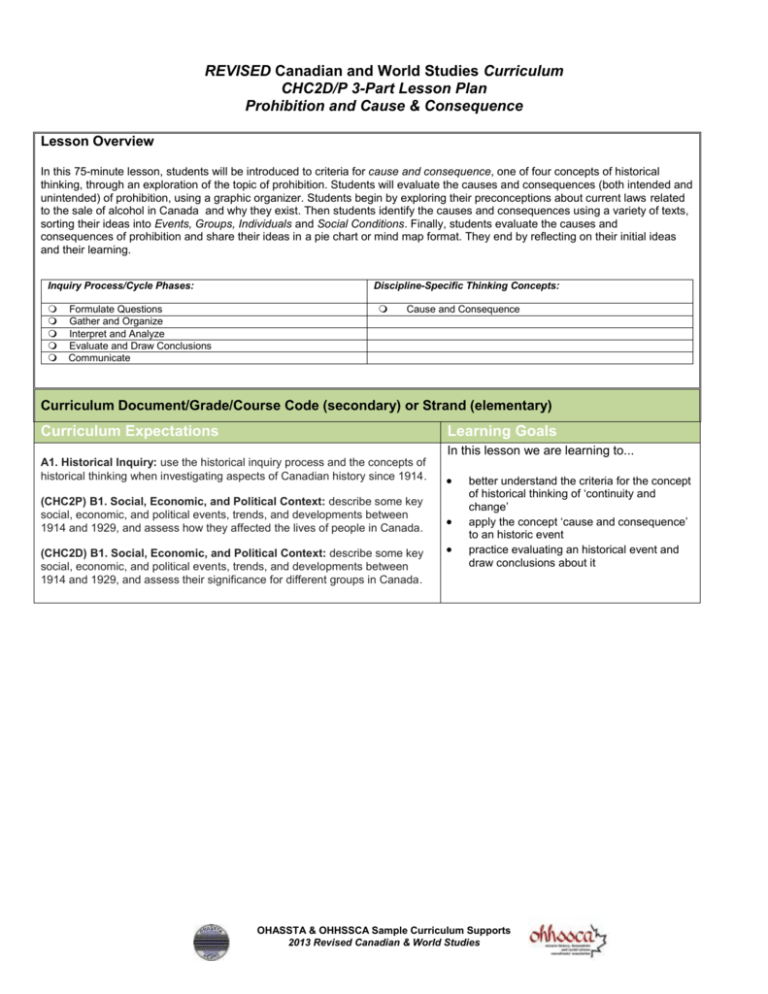
REVISED Canadian and World Studies Curriculum CHC2D/P 3-Part Lesson Plan Prohibition and Cause & Consequence Lesson Overview In this 75-minute lesson, students will be introduced to criteria for cause and consequence, one of four concepts of historical thinking, through an exploration of the topic of prohibition. Students will evaluate the causes and consequences (both intended and unintended) of prohibition, using a graphic organizer. Students begin by exploring their preconceptions about current laws related to the sale of alcohol in Canada and why they exist. Then students identify the causes and consequences using a variety of texts, sorting their ideas into Events, Groups, Individuals and Social Conditions. Finally, students evaluate the causes and consequences of prohibition and share their ideas in a pie chart or mind map format. They end by reflecting on their initial ideas and their learning. Inquiry Process/Cycle Phases: Formulate Questions Gather and Organize Interpret and Analyze Evaluate and Draw Conclusions Communicate Discipline-Specific Thinking Concepts: Cause and Consequence Curriculum Document/Grade/Course Code (secondary) or Strand (elementary) Curriculum Expectations Learning Goals In this lesson we are learning to... A1. Historical Inquiry: use the historical inquiry process and the concepts of historical thinking when investigating aspects of Canadian history since 1914. (CHC2P) B1. Social, Economic, and Political Context: describe some key social, economic, and political events, trends, and developments between 1914 and 1929, and assess how they affected the lives of people in Canada. (CHC2D) B1. Social, Economic, and Political Context: describe some key social, economic, and political events, trends, and developments between 1914 and 1929, and assess their significance for different groups in Canada. better understand the criteria for the concept of historical thinking of ‘continuity and change’ apply the concept ‘cause and consequence’ to an historic event practice evaluating an historical event and draw conclusions about it OHASSTA & OHHSSCA Sample Curriculum Supports 2013 Revised Canadian & World Studies Instructional Components and Context Readiness Materials Students should have a basic understanding of the idea of Concepts of Historical Thinking Note: this lesson can be done at the beginning of the course as an introduction to the concept of Cause & Consequence Terminology Prohibition – (a law) Temperance – (an idea) Underlying causes - pre-existing social Index cards – one per student Paper and materials for creating pie charts and mind maps http://olc.spsd.sk.ca/DE/PD/instr/strats/think/ - tips for using the Think-PairShare strategy. Resources on Prohibition: Canadian Encyclopedia http://www.thecanadianencyclopedia.com/articles/prohibition (use Prohibition and Temperance Movement entries) Video clip “Our Investment of Blood” from Canada: A People’s History (CBC, 2001) OHASSTA-OHHSSCA Concepts of Historical Thinking poster Cause & Consequence Organizer handout – one copy per student CHC2DP Working with Causes and Consequences handout Exit Card (index card) conditions, people, groups, and prior events Trigger cause - the tipping point, an individual’s or a group’s action, or an event that initiates change OHASSTA & OHHSSCA Sample Curriculum Supports 2013 Revised Canadian & World Studies Minds On Connections Establishing a positive learning environment Connecting to prior learning and/or experiences Setting the context for learning Think-Pair-Share Strategy The 1918 Prohibition Law Assessment: Assessment FOR learning Description 1. Begin by asking students to think about the following question: “How is the sale of alcohol regulated today in Canada? (This is introducing some consequences and accessing prior knowledge). 2. Define the terms Prohibition (the law) and Temperance (the idea) and post definitions in the classroom. 3. Use a Think-Pair-Share strategy to help students consider the following: “What might be some reasons that caused the Canadian government to pass Prohibition of Alcohol into law in 1918?” Have students brainstorm possible reasons on their own, then in pairs and, finally, in small groups. Differentiated Instruction: students can journal their responses Quick Tips for Teachers: 4. Share as a class, record possible reasons (on the board or chart paper or reflective journal), and keep these for the conclusion of the activity. 5. Explain that students will be examining the causes of prohibition in Canada refer to the poster here. Their first task will be to identify various causes for a particular event using one or more accounts of the event. Also, by the end of the activity they will assess the relative influence of various causes of an event. OHASSTA & OHHSSCA Sample Curriculum Supports 2013 Revised Canadian & World Studies Visit http://olc.spsd.sk.ca/DE/PD/instr/strats/t hink/ for tips about how to use the Think-Pair-Share strategy. Action! Connections Introducing new learning or extending/reinforcing prior learning Providing opportunities for practice and application of learning (guided > independent) Small Groups of 4 Exploring Cause and Consequence Description 1. Divide students into groups of 4. 2. Distribute the Cause and Consequence Organizer and explain that students will add relevant people, ideas and events to both sides of the chart. 3. Teachers should explain the difference between underlying causes (preexisting social conditions, people, groups, and prior events) and trigger causes (the tipping point, an individual’s or a group’s action, or an event that initiates change). 4. Show the video clip “Our Investment of Blood” from Canada: A People’s History. Early in the clip, provide samples for students that model how to complete the organizer and ensure that they understand each of the categories (see Terminology). 5. Then, invite students, in their groups, to collaborate after viewing the rest of the clip to add causes and consequences to the organizer. 6. Provide each group with a reading from the Canadian Encyclopedia. Students should continue to add as many causes and consequences as possible to their organizer as they read, referring to criteria on the poster. 7. Hand out an index card to each student. Have students label one side ‘Cause’ and the other side ‘Consequence’. 8. In the groups, each group member selects a different category from the organizer (Groups, Individuals, Events, Social Conditions). On their index card, each student writes down what they think is the most important cause and the most important consequence in their selected category. 9. Assessment: Assessment for learning When ready, ask the class to hold up the Cause side of their index card and notice the similarities and differences between the ideas. Then repeat with Consequences. Circulate among the groups to help students when/if questions emerge Use the opportunity to deepen understanding and clear up any misconceptions Assessment as learning Peers can provide feedback on each other’s charts Differentiated Instruction: If groups complete working with a resource early, they can work with the second resource, or another provided by teacher Resources can be differentiated by using video clips, articles, websites Arrange students in mixed groups o Add or substitute other accessible readings Quick Tips for Teachers: OHASSTA & OHHSSCA Sample Curriculum Supports 2013 Revised Canadian & World Studies Provide other possible text resources depending on the needs of the students See the CHC2DP Working with Causes and Consequences handout for some prompting questions to assist students in their reading Consolidation Connections Providing opportunities for consolidation and reflection Helping students demonstrate what they have learned New Groups of 4 Graphic Organizer Analysis Assessment: Assessment as learning Description Differentiated Instruction: 1. 2. Create new small groups so that students work with new peers. To do so, have the students, within their groups, number themselves off 1-4. Numbers 1 and 2 will move to a new group and 3 and 4 will stay where they are. Assign half the groups to examine “Causes” and the other half of the groups to examine “Consequences.” a. The “Causes” groups will assess the relative influence of the various causes of the Canadian government passing Prohibition into law (refer to criteria on the poster). Students complete a pie chart on chart paper to illustrate the most influential causes of prohibition. Each ranking (section of the pie chart) will be accompanied by a justification. Each group shares their conclusions with the class for peer feedback. b. The “Consequences” group will use counterfactuals (“what if?” scenarios) to explore consequences. Have students answer in mind map form on chart paper: “What might be different in Canada had prohibition not passed into law?” Students’ answers should address the groups, individuals, events and ideas sections, and they must be prepared to defend their choices. Each group shares their conclusions with the class for peer feedback. Direct student groups to examine the possible causes and consequences they wrote at the start of this activity. Students then complete an Exit Card individually to answer these two questions: “How do the actual causes of Prohibition compare to what you thought caused it? What consequences were unexpected or unintended?” Instead of using an Exit Card, students can write a journal response Quick Tips for Teachers: OHASSTA & OHHSSCA Sample Curriculum Supports 2013 Revised Canadian & World Studies #1a) Possible answers - Things that might have been affected: women’s rights, tobacco control policy, drinking rates, public drinking laws, legal drinking age, possible marijuana policy, less investigation into other social problems (e.g. domestic abuse) #1b) Discussion should address issues related to alcohol, but also women’s rights and social improvement, government regulation as unintended consequences Refer to The Big Six, pg 125 (Nelson) for further instruction on how to use counterfactuals

